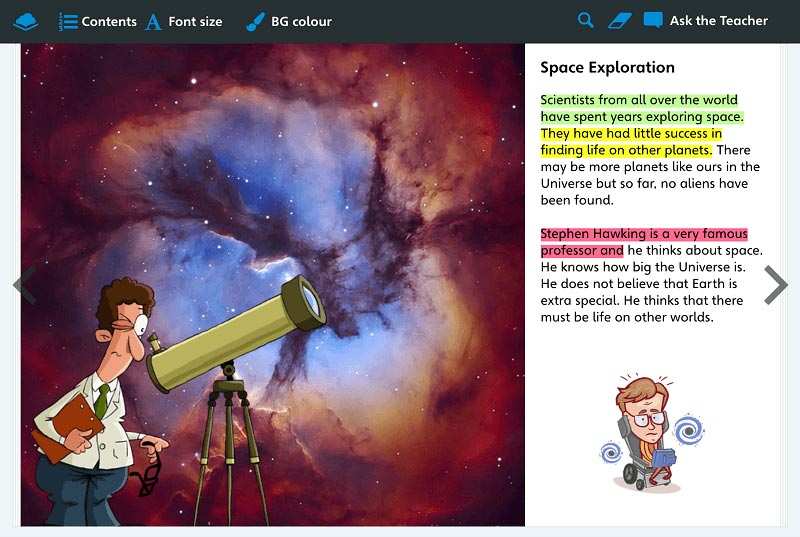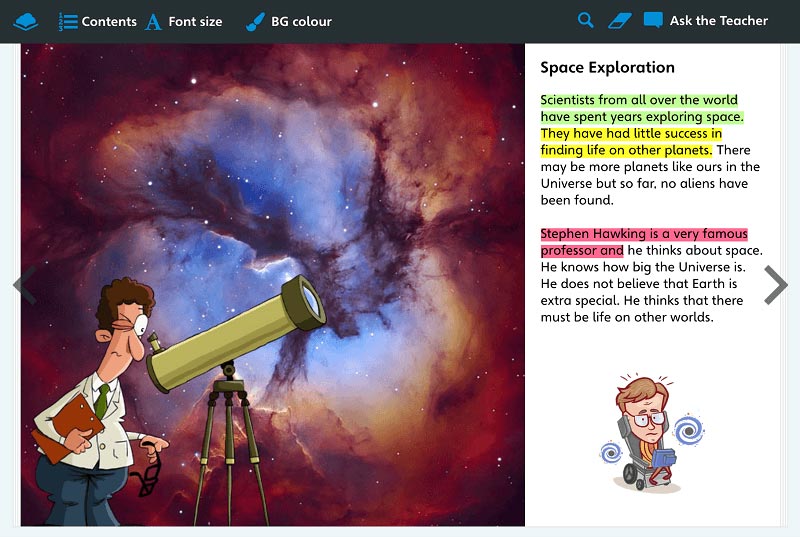
The perfect tool for demonstrating understanding
May 22, 2017 | 8years | Press Releases
Here’s the problem with highlighting: Every day pupils highlight words in books. Their teachers hope that the words will resonate, be reviewed and spark some thought. For most though, highlighted words don’t do that.
Pages are carefully marked up in line with what the teacher is saying. Then the book is closed and the words and annotations are forgotten. Even if the books are reopened, the highlighted words often seem to have lost their importance without the teacher alongside to explain.
It’s enough to make you wonder why you should even spend time highlighting. What’s a teacher to do? You could try highlighting in the Giglets literacy resource.
Using the innovative Giglets online reading resource, you can give each one of your pupils their own copy of a digital book, and provided highlighting tools support your pupils as they access each book.
Highlighting or text marking when reading is an important skill to practise. It allows your pupils to interact with a text and can be a great indicator of understanding.
When you highlight a paper book, the highlighting is there forever. You highlight and then (hopefully) you review. Highlighting books on Giglets is a much more engaging experience.
In the Giglets literacy resource, notes and highlighting can be changed or removed. Highlight a paragraph in yellow then change it to blue or green, or delete it if you need to. Teachers can also ‘share’ their own highlighted notes with their class; the teacher adds a thought or explanation to some text, and every pupil can see that note inside their own copy.

Here are just a few ways that TLC teachers use highlighting to best effect:
Or highlight words, phrases or sentences that:
Encourage your pupils to investigate the words and ideas they’ve highlighted in yellow or red. They can add their findings to a note on their highlighted word(s). Move on to a class discussion of some of the unfamiliar words and ideas. Take some time to talk through the new words and ideas in some detail.
When they read the text through, your pupils may change the highlighting colours to show that they understand a little more than they did at first.
Teachers can also model ‘highlighting as you read’ to teach pupils good highlighting habits. You’ll find that your pupils enjoy using interactive highlighting tools and they’ll become better learners by independently interacting with a text.
The tools, materials and strategies on the Giglets literacy resource will help you develop outstanding practice in reading in your classroom. For a free trial or any further information contact us and we will explain how our technology can work for you.
Pages are carefully marked up in line with what the teacher is saying. Then the book is closed and the words and annotations are forgotten. Even if the books are reopened, the highlighted words often seem to have lost their importance without the teacher alongside to explain.
It’s enough to make you wonder why you should even spend time highlighting. What’s a teacher to do? You could try highlighting in the Giglets literacy resource.
Using the innovative Giglets online reading resource, you can give each one of your pupils their own copy of a digital book, and provided highlighting tools support your pupils as they access each book.
Highlighting or text marking when reading is an important skill to practise. It allows your pupils to interact with a text and can be a great indicator of understanding.
When you highlight a paper book, the highlighting is there forever. You highlight and then (hopefully) you review. Highlighting books on Giglets is a much more engaging experience.
In the Giglets literacy resource, notes and highlighting can be changed or removed. Highlight a paragraph in yellow then change it to blue or green, or delete it if you need to. Teachers can also ‘share’ their own highlighted notes with their class; the teacher adds a thought or explanation to some text, and every pupil can see that note inside their own copy.

Here are just a few ways that TLC teachers use highlighting to best effect:
1. Give pupils a prompt instead of a passage to highlight.
Ask your pupils to use different colours to distinguish the different effects of the words. Highlight:- Words that describe how the character feels.
- Words that tell us what the character did.
- Words that describe the setting/where the events take place.
Or highlight words, phrases or sentences that:
- you agree with;
- you disagree with; or
- make you want to ask a question.
2. Use colours to show understanding and progress.
Ask your pupils to skim and scan some text. Support your pupils by selecting some words or ideas you want them to think about. Pupils should highlight:- Green: Words or ideas they already understand.
- Yellow: Words or ideas they’ve heard of or know a little bit about.
- Red: Words or ideas they’ve never seen or heard of before.
Encourage your pupils to investigate the words and ideas they’ve highlighted in yellow or red. They can add their findings to a note on their highlighted word(s). Move on to a class discussion of some of the unfamiliar words and ideas. Take some time to talk through the new words and ideas in some detail.
When they read the text through, your pupils may change the highlighting colours to show that they understand a little more than they did at first.
3. Get ahead of the questions.
The teacher reads and highlights their copy of a book to:- add explanation to difficult words or phrases;
- direct pupils on which sections to read; or
- provide specific questions for pupils to answer in class/at home.
Teachers can also model ‘highlighting as you read’ to teach pupils good highlighting habits. You’ll find that your pupils enjoy using interactive highlighting tools and they’ll become better learners by independently interacting with a text.
The tools, materials and strategies on the Giglets literacy resource will help you develop outstanding practice in reading in your classroom. For a free trial or any further information contact us and we will explain how our technology can work for you.
